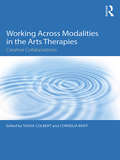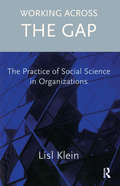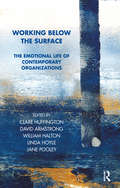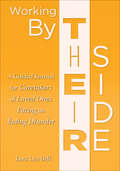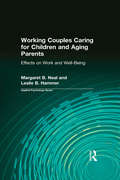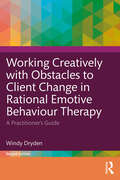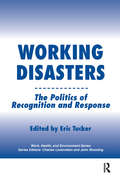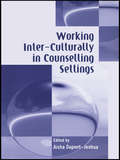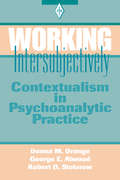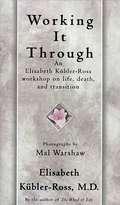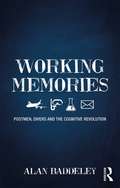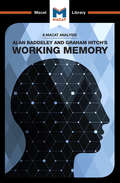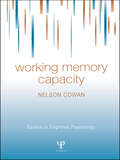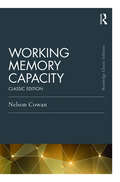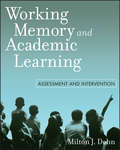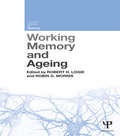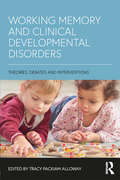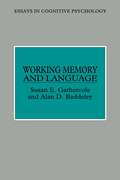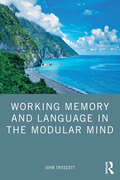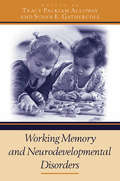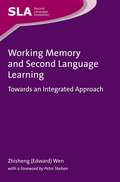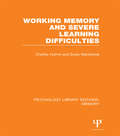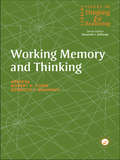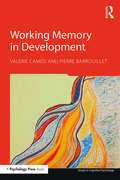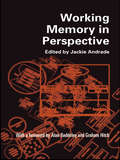- Table View
- List View
Working Across Modalities in the Arts Therapies: Creative Collaborations
by Tasha Colbert Cornelia BentWorking Across Modalities in the Arts Therapies: Creative Collaborations offers an in-depth insight into cross-modality and transdisciplinary practice in the arts therapies. Including contributions from drama, music, dance movement and art therapists, as well as professionals from related disciplines, it vividly demonstrates how the alchemy of these collaborations produces innovative interventions and new approaches to working with clients. Compelling examples of collaborative practice cover a variety of client groups, ranging from Syrian refugee children and women with eating disorders, to homeless war veterans and sex offenders. Together, the authors make the case for the effectiveness of cross-modal and transdisciplinary approaches when working with otherwise hard-to-reach and complex populations. This book is a guide to good practice and an invaluable resource for both experienced arts therapists and those new to the field. It will also be of benefit to healthcare and education professionals, arts practitioners, and anyone with an interest in the subject.
Working Across the Gap: The Practice of Social Science in Organizations
by Lisl KleinThe author's experience of applying the social sciences in organizations must be unique. Her work is grounded in research but much of her professional activity has been in application, combining the methods and findings of research with an understanding of dynamics in working with organizations. Moving between research and practice she has, for nearly forty years, pursued the aim of rendering the social sciences useful and practical in organizational life. This collection of papers brings together wide-ranging material that is highly relevant to today's world, whilst also providing a useful historical overview of the field. The links between research, policy and practice are brought vividly to life, the many examples creating a thread that connects theory with operational reality. The author provides an insightful and significant theory of practice, developed through vignettes of her work and experience that make this a very readable and engaging book.
Working Below the Surface: The Emotional Life of Contemporary Organizations (Tavistock Clinic Series)
by David Armstrong Jane Pooley Clare Huffington William Halton Linda HoyleThe chapters contributed to this book have been written by the staff and associates of The Tavistock Consultancy Service, whose distinctive competence is in the human dimension of enterprise and the dynamics of the workplace. The intention is to identify and explore some of the key themes that have emerged, such as the emotional world of the organisation and the dynamics of resistance to change, and how these affect and influence the understanding of leadership and management in contemporary organizations. No attempt is made to reach a consensus, but rather to raise and map out a territory of continuing question and debate. Contributors:David Armstrong; Andrew Cooper; Tim Dartington; William Halton; Sharon Horowitz; Linda Hoyle; Clare Huffington; Kim James; Sarah Miller; Anton Obholzer; Jane Pooley; and Nick Temple. Part of the Tavistock Clinic Series.
Working By Their Side: A Guided Journal for Caretakers of Loved Ones Facing an Eating Disorder
by Lara Lyn BellFor caretakers of those struggling with eating disorders, this workbook and journal helps process and utilize the guidance offered in By Their Side. The Lara Lyn Bell team knows the healing power of journaling firsthand. In Working By Their Side, they offer guidance for further reflection on the advice, testimonials, and resources found in By Their Side.Working By Their Side fosters meaningful discovery through prompts that encourage openness and honesty. The workbook’s educational components prepare readers to fully engage in treatment, giving them a healthy head start in therapy that can put them years ahead in the process.
Working Couples Caring for Children and Aging Parents: Effects on Work and Well-Being (Applied Psychology Series)
by Margaret B. Neal Leslie B. HammerAs the baby boomer generation approaches midlife, many dual-earner couples are struggling with issues of simultaneously caring for children while tending to aging parents. This timely book uncovers the circumstances faced by these workers, known as the “sandwiched generation”, and identifies what they need in order to fulfill their work and family responsibilities. Authors Margaret B. Neal and Leslie B. Hammer suggest the workplace as an arena for change, proposing that it adapt to the situations of today’s workers by providing flexibility and understanding the needs and priorities of families. Based on a four-year national study funded by the Alfred P. Sloan Foundation, Working Couples Caring for Children and Aging Parents examines: employer and governmental initiatives affecting work and family life in the United States; supports provided to working caregivers in countries other than the United States; the effects of being “sandwiched” on work-family fit, well-being, and work; and changes in work and family roles and outcomes over time. This book will interest a broad audience, including students, policymakers, family care practitioners, IO psychologists, work-life professionals, gerontologists, sociologists, human resource managers, and occupational health psychologists.
Working Creatively with Obstacles to Client Change in Rational Emotive Behaviour Therapy: A Practitioner’s Guide
by Windy DrydenProductive therapeutic change is facilitated when the therapist and client have a good therapeutic relationship, share views on salient therapeutic matters, agree on goals to enhance client well-being, and understand what they each have to do to achieve the goals of therapy. This book will address the obstacles to client change that both client and therapist bring to Rational Emotive Behaviour Therapy (REBT).Addressing these obstacles to client change head on, the book enables both the client and practitioner to move beyond problems in the consulting room and build a more productive relationship, resulting in more effective sessions and assisting in the resolution of underlying problems for which the client has sought help. This updated second edition will move beyond the language of 'resistance' in the first edition to instead reposition the term through the lens of barriers to change. A further emphasis will be placed on online therapy and barriers such as clients not attending as many sessions as a therapist might expect or recommend.This book is essential reading for any practitioner hoping to use REBT more effectively in their day-to-day practice.
Working Disasters: The Politics of Recognition and Response (Work, Health and Environment Series)
by Eric TuckerEvery day, workers are injured, made ill, or killed on the job. Most often, workers experience these harms individually and in isolation. Particular occurrences rarely attract much public attention beyond, perhaps, a small paragraph in the local newspaper. Instead, these events are normalized. This membrane of normalcy, however, is ruptured from time to time, especially after a disaster. This edited collection draws together original case studies written by leading researchers in Australia, Canada, Great Britain, Sweden, and the United States that examine the politics of working disasters. The essays address two fundamental questions: what gets recognized as a work disaster? And how does the state respond to one? In some instances, it seems self-evident that a disaster has occurred. For example, when a mine explodes killing tens or hundreds of workers simultaneously, the media and politicians recognize that this is not just a personal tragedy for the families of the victims, and that more troubling questions need to be asked about how this could happen. In other circumstances, however, the process that determines what gets recognized as a disaster is much more complicated. "Working Disasters" addresses the politics of recognition in case studies of the long-haul trucking industry, repetitive strain injuries, and lung disease in miners. Once it has recognized that a working disaster has occurred, the state typically goes beyond its routine responses to the daily toll of work-related deaths and injuries. Inquiries may be initiated to review the adequacy of regulatory systems and laws may be amended. Sometimes disasters produce meaningful change, but often they do not. In this text, the politics of response is considered in studies of a factory fire, the loss of an offshore oilrig, lung disease among miners, a mine explosion, and the prosecution of health and safety offences. This book will be of use to occupational health and safety activists and professionals; academics and upper-year students in: industrial relations, labour studies, labour history, law, political science, and sociology.
Working Inter-Culturally in Counselling Settings
by Aisha Dupont-JoshuaWhat does it mean to work inter-culturally?Our multi-cultural society is changing the parameters of counselling. Working Inter-Culturally in Counselling Settings explores how racial issues can be recognised and worked within a practical, clinical setting. The book looks at how the counselling setting can influence practice, and the book includes chapters in a range of settings, including:* counselling training and supervision* social work* the probation service and prisons* setting up counselling services in culturally diverse communities.Aisha Dupont-Joshua, together with contributors of diverse cultural heritage, moves away from exclusive white models of thought, and adopts more of a world view, inclusive of cultural difference. Working Inter-Culturally in Counselling Settings will be invaluable for counsellors, trainers, supervisors and other mental health professionals.
Working Intersubjectively: Contextualism in Psychoanalytic Practice (Psychoanalytic Inquiry Book Series #17)
by Donna M. Orange Robert D. Stolorow George E. AtwoodFrom an overview of the basic principles of intersubjectivity theory, Orange, Atwood, and Stolorow proceed to contextualist critiques of the concept of psychoanalytic technique and of the myth of analytic neutrality. They then examine the intersubjective contexts of extreme states of psychological disintegration, and conclude with an examination of what it means, philosophically and clinically, to think and work contextually. This lucidly written and cogently argued work is the next step in the development of intersubjectivity theory. In particular, it is a clinically grounded continuation of Stolorow and Atwood's Contexts of Being (TAP, 1992), which reconceptualized four foundational pillars of psychoanalytic theory -- the unconscious, mind-body relations, trauma, and fantasy -- from an intersubjective perspective. Working Intersubjectively expounds and illustrates the contextualist sensibility that grows out of this reconceptualization. Like preceding volumes in the Psychoanalytic Inquiry Book Series by Robert Stolorow and his colleagues, it will be theoretically challenging and clinically useful to a wide readership of psychoanalysts and psychoanalytically informed psychotherapists.
Working It Through
by Elisabeth Kubler-RossThe companion guide to Elisabeth Kübler-Ross's famous workshops on death and dying This remarkable guide to coping with death and dying grew out of Dr. Elisabeth Kübler-Ross's realization that she could help larger numbers of terminally ill people directly by meeting with them in groups. The first such meeting in 1970 led to hundreds more throughout the United States and the world and now to Working It Through, a testament to "faith and the ability to survive and transcend the most difficult trials in life" as Kübler-Ross writes in her foreword. The photographer Mal Warshaw has documented the workshops, and his moving photographs bring this already powerful book to life.
Working Memories: Postmen, Divers and the Cognitive Revolution
by Alan BaddeleyTechnological developments during the Second World War led to an approach that linked ideas from computer science to neuroscience, linguistics, philosophy and psychology, known today as the Cognitive Revolution. Leaving behind traditional behaviourist approaches popular at the time, psychology began to utilise artificial intelligence and computer science to develop testable theories and design groundbreaking new experiments. The Cognitive Revolution dramatically changed the way that psychological research and studies were conducted and proposed a new way of thinking about the mind. In Working Memories, Alan Baddeley, one of the world's leading authorities on Human Memory, draws on his own personal experience of this time, recounting the radical development of a pioneering science in parallel with his own transatlantic, vibrant and distinguished career. Detailing the excitement and sometimes frustration experienced in taking psychology into the world beyond the laboratory, Working Memories presents unique insights into the mind and psychological achievements of one of the most influential psychologists of our time.
Working Memory
by Alexander O'Connor Birgit Koopmann-HolmThe work of memory researchers Alan Baddeley and Graham Hitch is a prime example of the ways in which good critical thinkers approach questions and the problems they raise. In the 1960s, researchers into human memory began to understand memory as comprising not one, but two systems. The first was a short-term system handling information for mere seconds. The second was a long-term system capable of managing information indefinitely. They also discovered, however, that short-term memory was not simply a ‘filing cabinet,’ as many had thought, but was actively working on cognitive – or mental – tasks. This is how the phrase “working memory” developed. The hypothesis remained unproven, however, presenting Baddeley and Hitch with the problem of working out how to produce definitive evidence that short term memory was a working system that actively manipulated and processed information. They responded by designing a series of ten experiments aimed at showing just this – presenting the results in their 1974 article, ‘Working memory.’ The research was a masterpiece of problem-solving that proved revelatory. The authors not only generated new solutions and made sound decisions between alternative possibilities – they also showed that short-term memory is indeed an active system responsible for information processing and managing, while also influencing attention, reasoning, reading comprehension and learning. While their work has since been refined by others, Baddeley and Hitch’s problem-solving approach helped to create the dominant understanding of working memory that underpins psychological research throughout the world today.
Working Memory Capacity (Essays in Cognitive Psychology)
by Nelson CowanThe idea of one's memory "filling up" is a humorous misconception of how memory in general is thought to work; it is actually has no capacity limit. However, the idea of a "full brain" makes more sense with reference to working memory, which is the limited amount of information a person can hold temporarily in an especially accessible form for use in the completion of almost any challenging cognitive task. This groundbreaking book explains the evidence supporting Cowan's theoretical proposal about working memory capacity, and compares it to competing perspectives. Cognitive psychologists profoundly disagree on how working memory is limited: whether by the number of units that can be retained (and, if so, what kind of units and how many?), the types of interfering material, the time that has elapsed, some combination of these mechanisms, or none of them. The book assesses these hypotheses and examines explanations of why capacity limits occur, including vivid biological, cognitive, and evolutionary accounts. The book concludes with a discussion of the practical importance of capacity limits in daily life.Incorporating the latest from the recent surge in research into working memory capacity limits and the remarkable new insights provided by neuroimaging techniques, this book serves as an invaluable resource for all memory researchers and is accessible to a wide range of readers.
Working Memory Capacity: Classic Edition (Psychology Press & Routledge Classic Editions)
by Nelson CowanThe idea of one's memory "filling up" is a humorous misconception of how memory in general is thought to work; it actually has no capacity limit. However, the idea of a "full brain" makes more sense with reference to working memory, which is the limited amount of information a person can hold temporarily in an especially accessible form for use in the completion of almost any challenging cognitive task. This groundbreaking book explains the evidence supporting Cowan's theoretical proposal about working memory capacity, and compares it to competing perspectives. Cognitive psychologists profoundly disagree on how working memory is limited: whether by the number of units that can be retained (and, if so, what kind of units and how many), the types of interfering material, the time that has elapsed, some combination of these mechanisms, or none of them. The book assesses these hypotheses and examines explanations of why capacity limits occur, including vivid biological, cognitive, and evolutionary accounts. The book concludes with a discussion of the practical importance of capacity limits in daily life. This 10th anniversary Classic Edition will continue to be accessible to a wide range of readers and serve as an invaluable reference for all memory researchers.
Working Memory and Academic Learning
by Dehn Milton J.Equipping school and child psychologists, and neuropsychologists with critical information on the role of working memory in learning and achievement, Working Memory and Academic Learning offers guidance on assessment tools, interventions, and current evidence-based best practices. Its specific, step-by-step guidance and hands-on case studies enables you to identify how working memory relates to academic attainment and how to apply this knowledge in professional practice.
Working Memory and Ageing (Current Issues in Memory)
by Robert H. Logie Robin G. MorrisThe rapid growth in the numbers of older people worldwide has led to an equally rapid growth in research on the changes across age in cognitive function, including the processes of moment to moment cognition known as working memory. This book brings together international research leaders who address major questions about how age affects working memory: Why is working memory function much better preserved in some people than others? In all healthy adults, which aspects of working memory are retained in later years and which aspects start declining in early adulthood? Can cognitive training help slow cognitive decline with age? How are changes in brain structures, connectivity and activation patterns related to important changes in working memory function? Impairments of cognition, and particularly of working memory, can be major barriers to independent living. The chapters of this book dispel some popular myths about cognitive ageing, while presenting the state of the science on how and why working memory functions as it does throughout the adult lifespan. Working Memory and Aging is the first volume to provide an overview of the burgeoning literature on changes in working memory function across healthy and pathological ageing, and it will be of great interest to advanced undergraduates, postgraduates and researchers in psychology and related subject areas concerned with the effects of human ageing, including several areas of medicine.
Working Memory and Clinical Developmental Disorders: Theories, Debates and Interventions
by Tracy Packiam AllowayThis comprehensive volume brings together international experts involved in applying and developing understanding of Working Memory in the context of a variety of neurodevelopmental disorders, neurocognitive disorders, and depressive disorders. Each chapter provides a description of the disorder and investigates the Working Memory and related Executive Function deficits. It goes on to provide a neurological profile, before exploring the impact of the disorder in daily functions, the current debates related to this disorder, and the potential effects of medication and intervention. Through combining coverage of theoretical understanding, methods of assessment, and different evidence-based intervention programs, the book supports clinical assessment and management of poor Working Memory. It is essential reading for students in neurodevelopmental disorders, atypical development and developmental psychopathology as well as allied health professionals, clinicians and those working with children in education and healthcare settings.
Working Memory and Language (Essays in Cognitive Psychology)
by Susan E. Gathercole Alan D. BaddeleyThis book evaluates the involvement of working memory in five central aspects of language processing: vocabulary acquisition, speech production, reading development, skilled reading, and comprehension. The authors draw upon experimental, neuropsychological and developmental evidence in a wide-ranging evaluation of the contribution of two components of working memory to each aspect of language. The two components are the phonological loop, which is specialised for the processing and maintenance of verbal material, and the general-purpose processing system of the central executive.A full introduction to the application of the working memory model to normal adults, neuropsychological patients and children is provided in the two opening chapters. Non-experts within this area will find these chapters particularly useful in providing a clear statement of the current theoretical and empirical status of the working memory model. Each of the following chapters examines the involvement of working memory in one specialised aspect of language processing, in each case integrating the available experimental, neuropsychological and developmental evidence. The book will therefore be of direct relevance to researchers interested in both language processing and memory.Working Memory and Language is unique in that it draws together findings from normal adults, brain-damaged patients, and children. For each of these populations, working memory involvement in language processing ranging from the speech production to comprehension are evaluated. Working Memory and Language provides a comprehensive analysis of just what roles working memory does play in the processing of language.
Working Memory and Language in the Modular Mind
by John TruscottThe book explores two fundamental aspects of the human mind and their relation to one another. The first is the way that information is put to use in the mind. When we are doing a mental arithmetic problem, for example, how do we bring the relevant bits of information to mind and hold them there while carrying out the series of calculations? This is working memory, the subject of an enormous research literature in psychology, neuroscience, and a great many other disciplines. Characterizing the working memory process is now a major part of efforts to understand the human mind. How we characterize this process depends of course on how we characterize the human mind as a whole. In particular, is the mind made up of a number of distinct units, each carrying out a specialized function? There is considerable reason to say that it is, and this modular view of the mind has become prominent in a great deal of academic work, notably in cognitive neuroscience, with important implications for our understanding of how working memory works. But these implications have received surprisingly little consideration to this point. The aim of the book is to explore this relation between working memory and modularity, first in general terms and then using a specific modular view of the mind – the Modular Cognition Framework. The ideas are illustrated and further developed through an application to language and especially second language acquisition and use.
Working Memory and Neurodevelopmental Disorders
by Susan E. Gathercole Tracy Packiam AllowayShort-term or working memory - the capacity to hold and manipulate information mentally over brief periods of time - plays an important role in supporting a wide range of everyday activities, particularly in childhood. Children with weak working memory skills often struggle in key areas of learning and, given its impact on cognitive abilities, the identification of working memory impairments is a priority for those who work with children with learning disabilities. Working Memory and Neurodevelopmental Disorders supports clinical assessment and management of working memory deficits by summarising the current theoretical understanding and methods of assessment of working memory. It outlines the working memory profiles of individuals with a range of neurodevelopmental disorders (including Down's syndrome, Williams syndrome, Specific Language Impairment, and ADHD), and identifies useful means of alleviating the anticipated learning difficulties of children with deficits of working memory. This comprehensive and informative text will appeal to academics and researchers in cognitive psychology, neuropsychology and developmental psychology, and will be useful reading for students in these areas. Educational psychologists will also find this a useful text, as it covers the role of working memory in learning difficulties specific to the classroom.
Working Memory and Second Language Learning: Towards an Integrated Approach
by Zhisheng Edward WenThis book introduces an approach to understanding and measuring working memory components and functions in second language learning, processing and development. It presents comprehensive, thorough and updated reviews of relevant literatures from cognitive sciences and applied linguistics. Drawing on multidisciplinary research, the book advocates a conceptual framework for integrating working memory theories with second language acquisition theories. An innovative theoretical model is also presented, which illuminates research studies investigating the distinctive roles of phonological and executive working memory as they relate to specific L2 learning domains, skills and processes. Theoretical and methodological implications of this integrative perspective are further elaborated and discussed within the specific realms of L2 task-based performance and language aptitude research.
Working Memory and Severe Learning Difficulties (Psychology Library Editions: Memory)
by Charles Hulme Susie Mackenzie"Working memory" is a term used to refer to the systems responsible for the temporary storage of information during the performance of cognitive tasks. The efficiency of working memory skills in children may place limitations on the learning and performance of educationally important skills such as reading, language comprehension and arithmetic. Originally published in 1992, this monograph considers the development of working memory skills in children with severe learning difficulties. These children have marked difficulties with a wide range of cognitive tasks. The studies reported show that they also experience profound difficulties in verbal working memory tasks. These memory problems are associated with a failure to rehearse information within an articulatory loop. Training the children to rehearse material is shown to help alleviate these problems. The implications of these studies for understanding normal memory development, and for models of the structure of working memory and its development are discussed. It is argued that the working memory deficits seen in people with severe learning difficulties may contribute to their difficulties on other cognitive tasks.
Working Memory and Thinking: Current Issues In Thinking And Reasoning (Current Issues in Thinking and Reasoning)
by Robert H. Logie Kenneth GilhoolyThinking and memory are inextricably linked. However, a "divide and rule" approach has led cognitive psychologists to study these two areas in relative isolation. With contributions from some of the leading international researchers on working memory and thinking, the present volume aims to break down the scientific divisions and foster scientific integration in the connections between these two core functions of cognition. Broadly defined, thinking comprises mentally driven change in current representations. The processes involved in such change include application of logical rules, heuristics, problem solving strategies, decision making, planning and comprehension of complex material. Memory involves the encoding, retention and retrieval of information, and the retention may be temporary or in a long-term knowledge base.; Thinking cannot occur in a vacuum; it relies on the long-term memory base and a temporary mental workspace. Despite the apparent limitations on mental workspace, humans can drive a car and hold a conversation, or store partial solutions while tackling other aspects of a problem. So too, some aspects of thinking are relatively resilient in the face of quite extensive brain damage, yet other aspects are remarkably vulnerable to neuroanatomical insults. Humans can solve complex problems with many alternative choice points and yet seem to be able to consider only a few hypotheses at any one time. These apparent paradoxes present significant scientific challenges as to how humans can be such successful thinkers despite their very limited working memory. The chapters herein represent a diversity of views as regards the nature or working memory and forms of human thinking. The links between working memory and thinking are directly addressed and made explicit, and in so doing this volume offers an increasingly integrated understanding of human thinking and memory.
Working Memory in Development (Essays in Cognitive Psychology)
by Valérie Camos Pierre BarrouilletWorking memory is the system responsible for the temporary maintenance and processing of information involved in most cognitive activities, and its study is essential to the understanding of cognitive development. Working Memory in Development provides an integrative and thorough account of how working memory develops and how this development underpins childhood cognitive development. Tracing back theories of cognitive development from Piaget's most influential theory to neo-Piagetian approaches and theories pertaining to the information-processing tradition, Camos and Barrouillet show in Part I how the conception of a working memory became critical to understanding cognitive development. Part II provides an overview of the main approaches to working memory and reviews how working memory itself develops across infancy and childhood. In the final Part III, the authors explain their own theory, the Time-Based Resource-Sharing (TBRS) model, and discuss how this accounts for the development of working memory as well providing an adequate frame to understanding the role of working memory in cognitive development. Working Memory in Development effectively addresses central and debated questions related to working memory and is essential reading for students and researchers in developmental, cognitive, and educational psychology.
Working Memory in Perspective
by Jackie AndradeThe Baddeley and Hitch (1974) Working Memory model holds a central place in experimental psychology and continues to be extremely successful in guiding and stimulating research in applied and theoretical domains. Yet the model now faces challenges from conflicting data and competing theories. In this book, experienced researchers in the field address the question: Will the model survive these challenges? They explain why it is so successful, evaluate its weaknesses with respect to opposing data and theories and present their vision of the future of the model in their particular area of research. The book includes a discussion of the "Episodic Buffer" component which has recently been added to the working memory model.The result is a comprehensive and critical assessment of the working memory model and its contribution to current research in human cognition, cognitive development, neuroscience and computational modelling. Furthermore, this collection serves as a case study to illustrate the range of factors that determine the success or failure of a theory and as a forum for discussing what researchers want from scientific theories. The book begins with an accessible introduction to the model for those new to the field and explains the empirical methods used in working memory research. It concludes by highlighting areas of consensus and suggesting a programme of research to address issues of continuing controversy. Working Memory in Perspective will be a valuable resource to students and researchers alike in the fields of human memory, language, thought and cognitive development.
